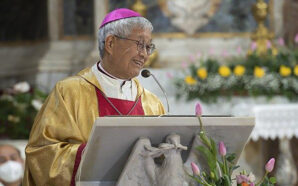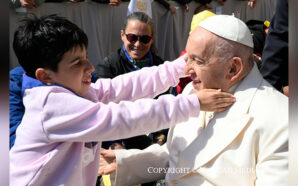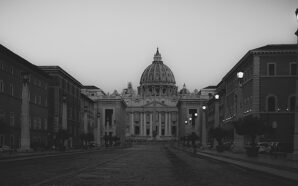First Sunday of Advent
Readings: Isaiah 2:1–5; Psalm 121(122):1–2, 4–5, 6–9; Romans 13:11–14; Matthew 24:37–44
27 November 2022
“The Son of Man is coming at an hour you do not expect.” – Matthew 24:44
The writers of the New Testament spoke not only of Christ who had come, but of the Christ who is coming. And Jesus spoke of his coming as a repeat of what happened in the days of Noah. In other words, people would not be expecting it, so would not be prepared. We are not to be constantly expecting the end of the world, but we are to properly understand his coming—to experience an Advent that will have meaning for our lives here and now.
When do we least expect Jesus? Not in the past. We know that he actually came into the world. Not out there in the future. We believe that someday he will return to the earth. The time we least expect him is today. So, we look for him, not in the clouds, but on the streets, among people who need him. We look for him in the face of a child; in the home where parents are out of work or out of love; in the bed of a sick friend; in the person who is in trouble at work or at school or at home; in the eyes of that person who is difficult to love.
Advent is an invitation to become spiritually alert, not alarmed. It is the season where we cultivate an awareness of Christ, that he will train our eyes to see him, not just in the past, or in the future, but now in many different ways every day.
Lord, help us to understand your coming as a present reality. Amen.
Fr Sean Cullen
Artwork Spotlight
The Calling of Saints Peter and Andrew – Michelangelo Merisi da Caravaggio (1571–1610)
The Calling of Saints Peter and Andrew (1602–1604). Oil on canvas, 176 x 140cm. Royal Collection, Hampton Court Palace, London. Public Domain.
“Who, me?” could well be the title of Caravaggio’s painting. Look at St Andrew pointing to himself incredulously when he hears Christ’s call: “Come after me and I will make you fishers of people” (Mk 1:17).
“Who, me?” could well be our own personal theme as we set out on the journey of Advent. To the uninitiated, Advent comes as a bit of a shock. We don’t run straight away into shepherds and kings and mangers and stars. Instead, the first Sunday begins with a bang: “You must stand ready because the Son of Man is coming at an hour you do not expect (Mt 24:44). Not only does our Lord refer to the end of time, but, more immediately, to our own death. So, if we accept this challenge to contemplate our mortality, then the first part of Advent will give us some themes to consider—a mini retreat, if you like. Then, if we wish to keep going, Advent Part Two will focus on preparing our hearts for Christ’s birth (within us).
Week One, then, presents us with this basic call of Christ: “Come after me.” Now, the Gospels are not stories, they are proclamations for all time. Christ is not just calling Peter and Andrew, he is also calling the reader, “Who, me?” Like many artists, Caravaggio dresses his subjects in contemporary clothes, a clever way of showing that the Gospel message is beyond time and space. The Gospel is for now.
The artist has painted a young Christ, unusually without a beard, perhaps again to portray timelessness. He gestures out of the painting in the direction in which he is moving, while turning back to the two brothers. The implication is that if they do not respond, then Jesus is going to walk calmly off without looking back again. It reminds us of the rich young man of St Matthew’s Gospel (cf. Mt 19:16–22). The young man could not accept the challenge. Jesus did not call him back, even though “Jesus looked steadily at him and was filled with love for him” (Mk 10:21). So, at the very outset of this New Year, we are faced with a basic choice: “Anyone who wants to save his life will lose it; but anyone who loses his life for my sake, and for the sake of the Gospel, will save it” (Mk 8:35). If I do not respond now, Christ may not call again.
Peter holds two fish skewered on sticks, and stares back in surprise at Christ’s words. He is clothed in traditional colours. He takes up most of the picture, emphasising his future important role in the early Church, for we know the end of the story. “And at once they left their nets and followed him” (Mk 1:18). Caravaggio, as usual, cleverly uses his mastery of light. It passes the two apostles to fall directly on Christ. St John will capitalise on this theme: “Anyone who follows me will not be walking in the dark, but will have the light of life” (Jn 8:12).
Christianity is not “all pie in the sky when you die” which was one of the Communist taunts. While Christ’s message reveals that we cannot possibly be fully happy in this life, it also reveals that while we are within this world, we must be fully committed to it. Our faith is not an excuse for escapism. The Second Vatican Council reminded us that as Christians we are called to be “artisans of a new humanity” (Gaudium et spes, 30). We are to show the world that the following of Christ not only makes us more holy, but more human. Advent will give us plenty to think about if we seriously accept its message.
The Calling of Saints Peter and Andrew, painted about 1604, belongs to the prestigious Royal Collection, and is normally on display at Hampton Court Palace. It actually came under the ownership of the British Royal Family as early as 1637, having been purchased by Charles I. It would later be bought again by Charles II before being passed onto Queen Elizabeth II. Its present value has been gauged at £50 million.
Monsignor Graham Schmitzer
Fr Sean Cullen is the parish priest of Corpus Christi Catholic Parish in Mittagong–Bowral. He was ordained in 1984 and has served in a number of parishes in the Diocese of Wollongong. Over the years, he has undertaken various diocesan roles including vocations director, master of ceremonies, chair of the Diocesan Liturgical Commission and member of the Council of Priests. He is currently the diocesan episcopal vicar for clergy.
Monsignor Graham Schmitzer is the retired parish priest of Immaculate Conception Parish in Unanderra, NSW. He was ordained in 1969 and has served in many parishes in the Diocese of Wollongong. He was also chancellor and secretary to Bishop William Murray for 13 years. He grew up in Port Macquarie and was educated by the Sisters of St Joseph of Lochinvar. For two years he worked for the Department of Attorney General and Justice before entering St Columba’s College, Springwood, in 1962. Fr Graham loves travelling and has visited many of the major art galleries in Europe.
With thanks to the Diocese of Wollongong, who have supplied this reflection from their publication, Incarnate – Advent & Christmas Daily Reflections 2022. Reproduced with permission.








